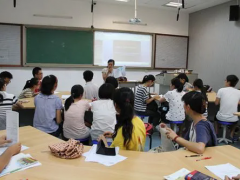形容词、副词总结
1.英语形容词副词的语法总结
形容词和副词 形容词 一.形容词的定义: 形容词表示人或事物的性质, 特征或状态, 修饰名词或不定代词 二.形容词在句中的作用: 作定语/作表语/作补语/作主语或宾语: the+adj表示某一类人或事物/作状语 三.关于形容词的作用要注意的问题: 1.有些形容词只能作表语和补语, 不能象普通形容词那样作前置定语, 这样的形容词称为表语形容词, 如: alive, alone, asleep, alike, afraid, awake, ashamed, able, sure, ill, worth等词; 表语形容词作定语时需后置 2.有些形容词只能作定语, 不能作表语, 这样的形容词称为定语形容词, 如: golden, wooden, silken, live(活的), elder(年长的), former前任的, latter后者, front前面的, back后面的, outer外部的 四.形容词在句中的位置: 1.单个形容词作定语时, 一般放在被修饰的名词之前; 两个或两个以上的形容词修饰一个名词时, 同种类形容词的排列顺序一般应考虑以下两种情况: ①.和被修饰的名词关系比较密切的形容词位置更靠近名词 a. It is a touching English film. ②.音节少的形容词在前, 音节多的形容词在后 a. I have a small but beautiful room. 不同种类的词同时出现在名词前作定语时, 按以下顺序进行排列: 数 词 性 状 形 容 词 冠词前的形容词 冠词,物主代词,指示代词,不定代词,所有格 序数词 基数词 性质 状态 数量 大小 长短 形状 新旧 温度 长幼 颜色 国籍 材料 来源 用途 all, both, such等 the, a, this, that another, your等 first, second, next等 one, five等 kind, good, sick等 large, long, round等 old cool等 red, blue等 Chinese English 等 iron, stone等 2.单个形容词作定语时, 在下列情况之下, 形容词应放在被修饰的词之后 ①.形容词修饰不定代词something, nothing, anything等时应后置 a. Is there anything important in the article? b. There is something difficult in the lesson. c. There is nothing wrong in your homework. ②.形容词修饰表示度量的名词应后置 a. The building is seventeen storeys high. b. He is ten years old. c. The street is five hundred meters long. ③.用and / or连接的两个形容词通常放在被修饰的名词之后, 起强调修饰语的作用 a. We will turn our motherland into a country, strong and modern. b. Every nation, big or small, has its rights. c. Power stations, large and small, have been set up all over the country. ④.有些过去分词形容词作定语时应后置, 如: given, left, won, missed等 a. None of the answers given (被给的答案) were correct. ⑤.表语形容词作定语时需后置, 如: alive, present, possible等 a. He is the greatest writer alive. b. He was the only person awake at the moment. 3.形容词短语作定语时, 需要后置 a. He is a worker worthy of praise. b. This is a problem difficult to solve. c. She is always ready to help others. 五.特殊的形容词: 有些以-ly结尾的词是形容词, 而不是副词, 这样的词如: friendly友好的, lovely可爱的, weekly每周的, orderly有秩序的, brotherly兄弟般的, lively活泼的, lonely孤独的, likely可能的, deadly致命的 副 词 一.副词的种类: 1.一般副词主要分为以下几种: ①.时间副词, 如: often, always, early, now ②.地点副词, 如: here, there, above, outside ③.方式副词, 如: hard, well, badly, fast, slowly ④.程度副词, 如: very, quite, much, still, almost 2.疑问副词(放在特殊疑问句的句首), 如: how, when, where, why 3.关系副词(放在定语从句句首), 如: when, where, why 4.连接副词(放在名词从句句首), 如: how, when, where, why, whether 二.副词在句中的作用: 副词修饰动词, 形容词, 名词, 副词或全句, 在句中的作用如下 1.作状语: a. You should always review your lessons. b. The visitors are warmly welcomed by the students. c. Certainly we should try out best to improve our work. 2.作表语: a. He is abroad. b. The class is over. c. The football match is on. 3.作定语: 副词作定语时置于被修饰词之后 a. This is her first day up. b. The comrades here give us a lot of help. 4.作补语(包括宾语补足语和主语补足语): a. I found all the lights on when I got home last night. 三.副词在句中的位置: 1.时间副词和地点副词的位置: ①.表示确定时间的副词和表示地点的副词一般放在句尾. 若句中同时有地点副词和时间副词, 地点副词通常在前, 时间副词在后 a. They went to the Summer Palace yesterday. b. We often goes there. c. I will go there tomorrow. ②.表示不确定时间的副词(如: always, usually, often, never, ever, seldom, sometimes, rarely, generally, frequently)的位置: 句子谓语是be时, 位于其后; 句子谓语是单个完全动词时, 位于其前; 句子谓语由不完全动词与完全动词一起组成时, 位于第一个不完全动词之后. a. She always helps her mother with the housework. b. The old man seldom goes out. c. He is always the first to come to class. d. They have already done their homework. 2.程度副词除enough之外, 一般放在被修饰词之前 a. The student is very careful with his work. b. He swims quite well. 。
2.英语形容词副词的语法总结
形容词和副词形容词一.形容词的定义: 形容词表示人或事物的性质, 特征或状态, 修饰名词或不定代词二.形容词在句中的作用: 作定语/作表语/作补语/作主语或宾语: the+adj表示某一类人或事物/作状语三.关于形容词的作用要注意的问题: 1.有些形容词只能作表语和补语, 不能象普通形容词那样作前置定语, 这样的形容词称为表语形容词, 如: alive, alone, asleep, alike, afraid, awake, ashamed, able, sure, ill, worth等词; 表语形容词作定语时需后置 2.有些形容词只能作定语, 不能作表语, 这样的形容词称为定语形容词, 如: golden, wooden, silken, live(活的), elder(年长的), former前任的, latter后者, front前面的, back后面的, outer外部的四.形容词在句中的位置: 1.单个形容词作定语时, 一般放在被修饰的名词之前; 两个或两个以上的形容词修饰一个名词时, 同种类形容词的排列顺序一般应考虑以下两种情况: ①.和被修饰的名词关系比较密切的形容词位置更靠近名词 a. It is a touching English film. ②.音节少的形容词在前, 音节多的形容词在后 a. I have a small but beautiful room. 不同种类的词同时出现在名词前作定语时, 按以下顺序进行排列: 数 词 性 状 形 容 词冠词前的形容词 冠词,物主代词,指示代词,不定代词,所有格 序数词 基数词 性质状态 数量大小长短形状 新旧温度长幼 颜色 国籍 材料来源用途all, both, such等 the, a,this, thatanother,your等 first,second,next等 one, five等 kind,good,sick等 large,long,round等 oldcool等 red,blue等 ChineseEnglish等 iron,stone等 2.单个形容词作定语时, 在下列情况之下, 形容词应放在被修饰的词之后 ①.形容词修饰不定代词something, nothing, anything等时应后置 a. Is there anything important in the article? b. There is something difficult in the lesson. c. There is nothing wrong in your homework. ②.形容词修饰表示度量的名词应后置 a. The building is seventeen storeys high. b. He is ten years old. c. The street is five hundred meters long. ③.用and / or连接的两个形容词通常放在被修饰的名词之后, 起强调修饰语的作用 a. We will turn our motherland into a country, strong and modern. b. Every nation, big or small, has its rights. c. Power stations, large and small, have been set up all over the country. ④.有些过去分词形容词作定语时应后置, 如: given, left, won, missed等 a. None of the answers given (被给的答案) were correct. ⑤.表语形容词作定语时需后置, 如: alive, present, possible等 a. He is the greatest writer alive. b. He was the only person awake at the moment. 3.形容词短语作定语时, 需要后置 a. He is a worker worthy of praise. b. This is a problem difficult to solve. c. She is always ready to help others.五.特殊的形容词: 有些以-ly结尾的词是形容词, 而不是副词, 这样的词如: friendly友好的, lovely可爱的, weekly每周的, orderly有秩序的, brotherly兄弟般的, lively活泼的, lonely孤独的, likely可能的, deadly致命的副 词一.副词的种类: 1.一般副词主要分为以下几种: ①.时间副词, 如: often, always, early, now ②.地点副词, 如: here, there, above, outside ③.方式副词, 如: hard, well, badly, fast, slowly ④.程度副词, 如: very, quite, much, still, almost 2.疑问副词(放在特殊疑问句的句首), 如: how, when, where, why 3.关系副词(放在定语从句句首), 如: when, where, why 4.连接副词(放在名词从句句首), 如: how, when, where, why, whether二.副词在句中的作用: 副词修饰动词, 形容词, 名词, 副词或全句, 在句中的作用如下 1.作状语: a. You should always review your lessons. b. The visitors are warmly welcomed by the students. c. Certainly we should try out best to improve our work. 2.作表语: a. He is abroad. b. The class is over. c. The football match is on. 3.作定语: 副词作定语时置于被修饰词之后 a. This is her first day up. b. The comrades here give us a lot of help. 4.作补语(包括宾语补足语和主语补足语): a. I found all the lights on when I got home last night.三.副词在句中的位置: 1.时间副词和地点副词的位置: ①.表示确定时间的副词和表示地点的副词一般放在句尾. 若句中同时有地点副词和时间副词, 地点副词通常在前, 时间副词在后 a. They went to the Summer Palace yesterday. b. We often goes there. c. I will go there tomorrow. ②.表示不确定时间的副词(如: always, usually, often, never, ever, seldom, sometimes, rarely, generally, frequently)的位置: 句子谓语是be时, 位于其后; 句子谓语是单个完全动词时, 位于其前; 句子谓语由不完全动词与完全动词一起组成时, 位于第一个不完全动词之后. a. She always helps her mother with the housework. b. The old man seldom goes out. c. He is always the first to come to class. d. They have already done their homework. 2.程度副词除enough之外, 一般放在被修饰词之前 a. The student is very careful with his work. b. He swims quite well. c. The boy i。
3.帮我总结形容词变副词,还有什么词变什么词,全部帮我归纳出来
1.一般情况下直接加“ly”,如quick---quickly 2.以“y”结尾的,先将“y”改成“i”,再加“ly”,如happy---happily
少数以e结尾的形容词,要去掉e再加-ly。例如:true-truly等。
但绝大多数以e结尾的形容词仍然直接加-ly。例如:polite-politely, wide-widely等。
形容词变副词通常是加ly,其变化有规律可循,请记住以下口诀:
一般直接加,“元e”去e加,“辅y”改i加,“le”结尾e改y。
分别举例如下:
quick—quickly,
true—truly,
happy—happily,
possible—possibly.
另外:
一、在形容词词尾直接加-ly。如:real-really; helpful-helpfully; careful-carefully; hopeful-hopefully; slow-slowly; quick-quickly; quiet-quietly
二、以辅音字母加y结尾的形容词要变y为i,然后再加-ly。如:busy-busily; angry-angrily; easy-easily
三、某些以辅音字母加不发音的字母e结尾和以-ue结尾的形容词要先去掉e,然后再加-y或-ly。如: terrible-terribly; true-truly; gentle-gently
另外,副词还可以由形容词加前缀a-得来,如:loud (adj.)-aloud (adv.)
此外,部分名词加后缀也可变成副词,如:part-partly。
例句: It is partly her fault. 有部分是她的错。
需注意: friendly; motherly; lovely等词是形容词而非副词。
再看转化副词。在英语中,有些词既可以作形容词,又可以作副词,如early, much, fast, little, wide, loud等。 由于这类词词性虽不同,但词形却一样,这就需要大家学会在特定语境中判断它们各自的词性。例句:Thank you very much. (adv.) 多谢。There is much water in the river. (adj.) 河里有很多水。The music is too loud. Please turn it down. (adj.) 音乐声太大,请调低点。He speaks loud enough. So everyone in the room can hear what he said. (adv.) 他说话的声音很大,所以房间里每个人都能听到他的话。
另外,还有一类副词和形容词词义相同,但拼写却不同,如well和good。例句He speaks good English. 他讲一口流利的英语。He speaks English well. 他英语讲得不错。
多音节y结尾的词 将y改为i后加ly easy-easily
happy-happily
heavy-heavily
单音节y结尾的词 直接加ly gay-gayly (gaily)
sly-slyly (slily)
以ve结尾的词 去e加ly true-truly
以le结尾的词 去e加y gentle-gently
possible-possibly
其他以e结尾的词 一律加ly nice-nicely
wise-wisely
polite-politely
以ll结尾的词 只加y full-fully
以ic结尾的词 加ally automatic-automatically
energetic-energetically
其他形容词 均加ly careful-carefully
glad-gladly
很高兴为你解答 满意请点下采纳 谢谢
4.英语形容词和副词的比较级和最高级的总结
形容词和副词的比较等级: 形容词和副词一般有三个等级,即原级、比较级和最高级.一般来说,表示两者同等或不同等程度时用原级,通常用“as + 形容词/ 副词原级 + as 。”
或“not as (so)+ 形容词/ 副词原级 + as 。”的结构. 例如: My brother is as tall as I. 我弟弟和我一样高. I will run as fast as I can. 我尽可能跑(和我能跑的速度一样快). The weather in Beijing is not so hot as that in Wuhan. 北京没有武汉热. 表示两者的比较时用比较级,通常用“形容词/ 副词比较级+than”的结构. 例如: I am much better than I was yesterday. 我比昨天好多了. Math is less interesting than English. 数学不如英语有兴趣. 表示一定范围内两者以上的比较时,用最高级,通常用“the + 形容词/ 副词最高级 (+名词) + of (in) 。”
的结构,只是副词最高级前可省去定冠词the. 例如: This is the busiest day of the week. 这是我本周最繁忙的一天. My sister sings best in my family. 我妹妹是我们家唱歌最好的.形容词和副词的比较级变化规则: 规则变化: (1) 单音节词直接在其后面加-er/-est.例如:tall-taller-tallest hard-harder-hardest (2) 以字母e结尾的单音节词在其后面直接加-r/-st.例如:brave-braver-bravest. (3) 以一个辅音字母结尾闭音节单音节词,双写这个辅音字母再加-er/-est. 例如:big-bigger-biggest;hot-hotter-hottest. (4) 以辅音字母+y结尾的双音节词,先把y改为i,再加-er/-est. 例如:happy-happier-happiest. (5) 其他双音节词和多音节的词,在前面加more和most.例如: interesting-more interesting-most interesting; carefully-more carefully-most carefully 不规则变化: good/well-better-best bad/ill-worse-worst many/much-more-most little-less-least far-farther-farthest badly-worse-worst 形容词和副词的比较级的其他用法: (1) 在同级比较的结构as/ so+原级+as。的前面可用just,almost,nearly和half等表示程度. 例如:He doesn't study half so hard as you. 他学习努力的程度不如你的一半. (2) 两者相比表示倍数的时候用twice (。
times) as+原级+as结构. 例如:His mistakes are twice as many as yours in the homework. 他家庭作业的错误是你的二倍. (3) 比较级前面可以用many,much,far,a little,a bit,a lot等词修饰表示程度. 例如:The sun is much bigger than the earth. 太阳比地球大多了. We will come back a little later. 我们会稍迟一点回来. (4) 比较级的前面可以用any和no来修饰. 例如:We were too tired to walk any farther. 我们太疲劳了不能再走很远了. He was no longer a child. 他不再是一个小孩子. (5) 两个形容词和副词的比较级可以叠加表示“越来越”的意思. 其结构可以是:比较级+and+比较级,而多音节词可以用more and more+比较级结构. 例如:The days are getting longer and longer. 天正变得越来越长了. Your sister becomes more and more beautiful. 你的妹妹变得越来越漂亮了. (6) 如果表示“越……,就越……”可以用“the+比较级……,the+比较级……”的结构. 例如:The harder you works, the more you will get. 你越努力学习,你得到的就越多. (7) 当比较的双方属于同一范围内时候,用other或者else排除自己,因为自己不能和自己比较. 例如:Shanghai is bigger than any other city in China. 上海比中国其他的城市大. 如果比较的双方不属于同一范围内时候,则不存在和自己比较的情况,所以可以不用other或者 else. 例如:Shanghai is bigger than any city in Heilongjiang. 上海比黑龙江的任何城市都大.最高级的用法 1. Spring is the best season of the year. 春天是一年中最好的季节. 2. She is the youngest in the class. 她是班里最年轻的.句型:A+动词+the+形容词最高级+of(in)… 表示三者或三者以上(人或事物)的比较,其中有一个在某一方面超过其他几个时,用最高级.最高级前面一般要加定冠词the,后面可带of(in)短语来说明比较的范围. 1. Tom is the happiest of us all. 汤姆是我们当中最幸福的. 2. This park is the most beautiful of the three. 这个花园是这三个中最漂亮的.of…和in…的区别 1.”of+复数”表示“在……之中的”;“在……中” of the four…… 在四个之中 of all(people) 在所有的人之中 of all the boys 在所有的男孩中 of us 在我们之中 of all things 在所有的事情当中 2.”in+范围、场所”译为“在……之中”;“在……之内” in the house 在家中 in China 在中国 in the world 在世界上 in our school 在我们学校 in my family 在我们家需注意的最高级用法 America is one of the most important countries for China. 对中国而言,美国是最重要的国家之—. My father is the tallest in my family. 在我家里,我父亲最高. 1.one of the +最高级,表示“是最……之一者” Shanghai is one of the most beautiful cities in China. 上海是中国最美丽的城市之—. Our city is one of the safest cities in the world. 我们城市是世界上最安全的城市之—. One of the most important languages is English. 最重要的语言之一是英语. 注意: one of the +最高级,后面要加上名词的复数,即为”one of the +最高级+复数名词” 2.”most+复数名词”、”most 。
5.求总结常见不规则形容词副词比较极最高极
常见不规则形容词副词比较极最高极是: good-better-best; well-better-best;
bad-worse-worst. badly-worse-worst. much-more-most. many-more-most;
little-less-least; old-older-oldest; old-elder-eldest.; far-father-farthest; far-further-furthest.
6.总结名词,形容词,副词等变化规则
英语中各种词性的转换 词性转换类型有: (1)v.-n.动词转化为名词, post-postage mail-mail weigh-weight advise-advice (2)v.-n.-a.动词转化成名词-形容词 act-actor / actress-active change-change-changeable (3) v.-a.-ad.-n.动词转化成形容词,副词,名词 fill-full need-necessary-necessarily interest(v. / n.) interested /interesting (4)n. a. n. a.名词转化为形容词 person personal ( 个人的; 私人的 ) fun funny (5)n. pl. n. pl.名词转化为名词复数 gentleman gentlemen human humans (6)a. ad. a. ad.形容词转化为副词 possible possibly probable probably (7)a. ad. n.形容词转化为副词,名词 true truly truth lucky luckily luck (8)原级 比较级 最高级 far farther / further farthest / furthest little less least ======================================== 还找到了另一种说明方法: 一、名词变为形容词的方法 1. 在名词后面加-y可以变成形容词(尤其是一些与天气有关的名词)。
例如:rain—rainy, cloud—cloudy, wind—windy, snow—snowy, health—healthy, luck—lucky等。 注意:1)如果名词以重读闭音节结尾,且词尾只有一个辅音字母,这时应双写词尾的辅音字母再加-y。
如:sun—sunny, fun—funny等。 2)少数以不发音的e结尾的名词变为形容词时,应去掉e再加-y。
例如:noise—noisy, ice—icy 等。 2. 一些抽象名词在词尾加-ful可以变为形容词。
例如:care—careful, thank—thankful, help—helpful, use—useful, beauty—beautiful等。 3. 一些表示国家的名词可以在词尾加-ese, -ish或-n构成表示国籍、语言的形容词。
例如:China—Chinese, Japan—Japanese, England—English, America—American, India—Indian, Australia —Australian(注意Canada—Canadian)。 4.在名词后加-ous变为形容词。
例如:danger—dangerous等。 5. 在名词后加-ly变为形容词。
例如:friend—friendly, love—lovely等。 6.在名词后加-less构成含有否定意义的形容词。
例如:care—careless(粗心的),use—useless(无用的),hope—hopeless(没希望的),home—homeless(无家可归的)等。 7. 一些以-ence结尾的名词,把ence改为ent变成形容词。
例如:difference—different, silence—silent等。 二、动词变为名词的方法 1.词形不变,词性改变。
例如:work, study, water, plant等可以用作动词,也可以用作名词。 2. 一些动词在词尾加上-er或-or之后就变成了表示“某一类人”的名词。
例如:work—worker, teach—teacher, sing—singer, jump—jumper, play—player, learn—learner, visit—visitor, invent—inventor等。 注意:1)以不发音的e结尾的动词,在词尾加-r。
例如:drive—driver, write—writer等。 2)以重读闭音节结尾,且末尾只有一个辅音字母的动词,应双写末尾的辅音字母,再加-er。
例如:run—runner, win—winner, begin—beginner等。 3. 在动词词尾加-ing变成名词(方法与动词变为现在分词的方法相同)。
例如: meet—meeting, build—building, wait—waiting, wash—washing, swim—swimming, shop—shopping, begin—beginning等。 三、形容词变为副词的方法 一般在形容词的词尾加-ly可以变成副词。
例如:quick—quickly, slow—slowly, loud—loudly, sudden—suddenly 等。但是,以下几点值得注意: 1. 一些以“辅音字母+y”结尾的形容词,要把y改为i再加-ly。
例如:happy—happily, angry—angrily, lucky—luckily, heavy—heavily, noisy—noisily 等。 2. 有些以-ble或-le结尾的形容词,去掉e加-y。
例如:possible—possibly, terrible—terribly等。 3. 少数以e结尾的形容词,要去掉e再加-ly。
例如:true—truly等。但绝大多数以e结尾的形容词仍然直接加-ly。
例如:polite—politely, wide—widely等。 4. 以-l结尾的形容词变为副词时仍然要在词尾加-ly,而不是只加-y。
除非是以-ll结尾的才在词尾只加-y。例如:usual—usually, careful—carefully, useful—usefully, full—fully等。
你多参考一下吧。 不规则的就没法儿总结了,只能靠死记硬背了。
加油吧。
7.形容词和副词的比较级归纳一点,谢谢了呃
形容词与副词的比较级
大多数形容词(性质形容词)和副词有比较级和最高级的变化,即原级、比较级和最高级,用来表示事物的等级差别。原级即形容词的原形,比较级和最高级有规则变化和不规则变化两种。
1) 规则变化
单音节词和少数双音节词,加词尾-er,-est来构成比较级和最高级。
构成法 原级 比较级 最高级
一般单音节词 tall(高的) taller tallest
未尾加-er,-est great(巨大的) greater greatest
以不发音的e结尾 nice(好的) nicer nicest
的单音词和少数 large(大的) larger largest
以- le结尾的双 able(有能力的) abler ablest
音节词只加-r,-st
以一个辅音字母 big(大的) bigger biggest
结尾的闭音节单 hot热的) hotter hottest
音节词,双写结
尾的辅音字母,
再加-er,-est
"以辅音字母+y" easy(容易的) easier easiest
结尾的双音节词,busy(忙的) busier busiest
改y为i,再加
-er,-est
少数以-er,-ow clever(聪明的) cleverer cleverest
结尾的双音节词 narrow(窄的) narrower narrowest
未尾加-er,-est
其他双音节词和 important(重要的)
多音节词,在前 more important
面加more,most most important
来构成比较级和 easily(容易地)
最高级。 more easily
most easily
2) 不规则变化
原级 比较级 最高级
good(好的)/ better best
well(健康的)
bad (坏的)/ worse worst
ill(有病的)
old (老的) older/elder oldest/eldest
much/many(多的) more most
little(少的) less least
far (远的) farther/further farthest/furthest







